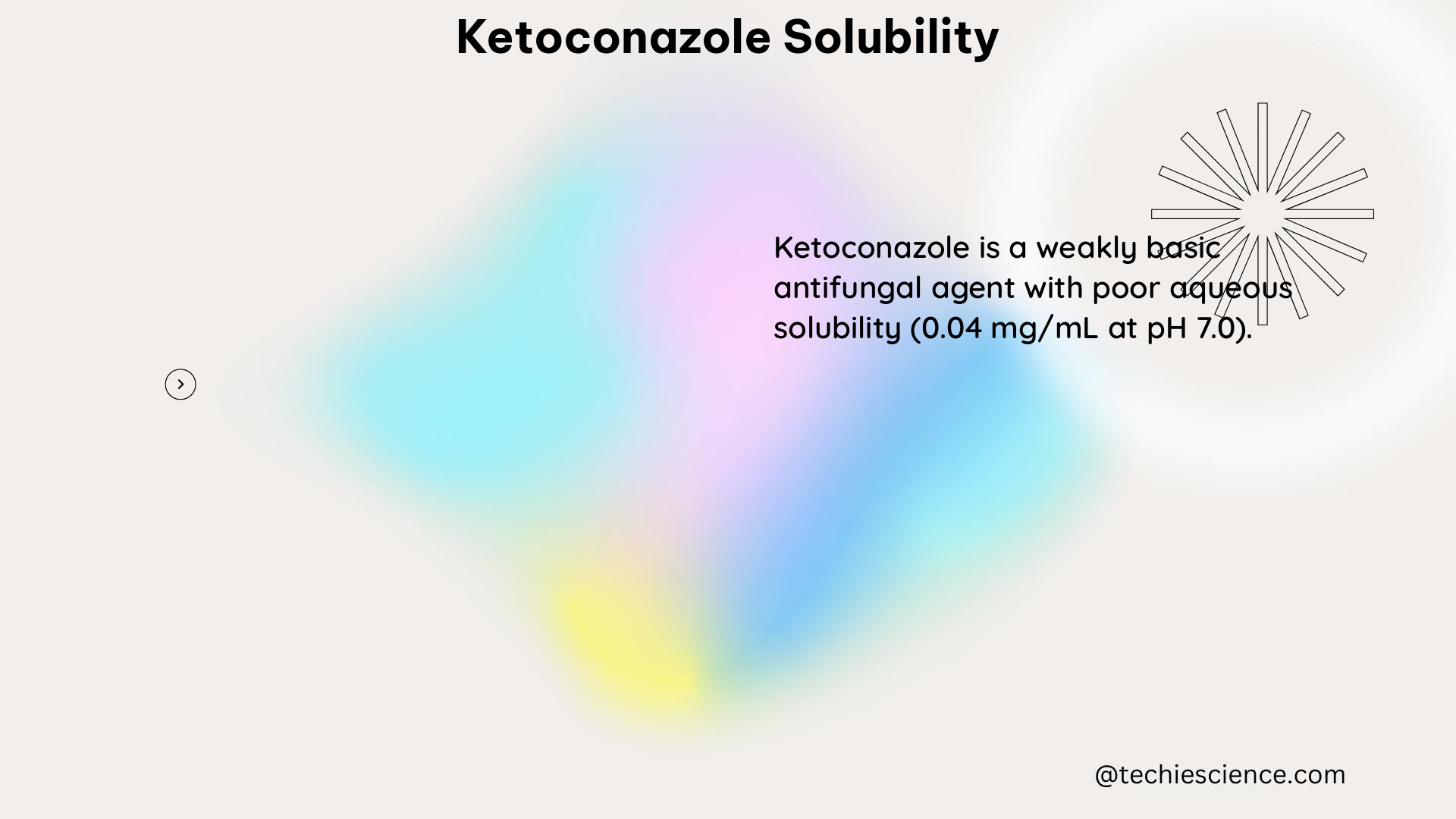Ketoconazole, a widely used antifungal medication, is known for its poor solubility, which poses a significant challenge in the development of effective pharmaceutical formulations. With a saturated solubility of only 21.044±0.759 ppm in water, as determined by spectrophotometry using a UV-Vis method, ketoconazole is classified as a Class II compound in the biopharmaceutics classification system, characterized by low aqueous solubility and high permeability.
Understanding Ketoconazole’s Solubility Profile
Ketoconazole’s solubility is influenced by various factors, including pH, solvents, and surfactants. Exploring these factors is crucial for enhancing the drug’s solubility and improving its bioavailability in pharmaceutical formulations.
pH-Dependent Solubility
Ketoconazole exhibits a pH-dependent solubility profile, with high solubility and stability at low pH values (< 3.0). As the pH increases, the dissolution rate of ketoconazole decreases. This pH-dependent behavior can be exploited in the design of pharmaceutical formulations that target specific regions of the gastrointestinal tract.
Solvent and Surfactant Effects
To improve the solubility of ketoconazole, researchers have investigated the use of various solvents and surfactants. The findings reveal that ketoconazole has the highest solubility in the following solvents and surfactants:
| Solvent/Surfactant | Solubility (mg/mL) |
|---|---|
| Clove oil | 156.17 ± 4.57 |
| Eucalyptus oil | 146.25 ± 3.56 |
| Tween 20 | 66.0 ± 4.5 |
| Span 80 | 56.0 ± 5.0 |
These solvents and surfactants can be effectively utilized to enhance the solubility and bioavailability of ketoconazole in pharmaceutical formulations.
Strategies for Improving Ketoconazole Solubility

To overcome the challenges posed by ketoconazole’s poor solubility, researchers have explored various strategies, including:
Cocrystal Formation
Cocrystallization is a promising approach to improve the solubility of ketoconazole. By forming cocrystals with suitable coformers, the solubility and dissolution rate of ketoconazole can be significantly enhanced. For example, a study has reported the formation of a ketoconazole-saccharin cocrystal, which exhibited a 2.5-fold increase in solubility compared to the pure drug.
Nanoparticle Formulations
The development of nanoparticle-based formulations has shown great potential in enhancing the solubility and bioavailability of ketoconazole. Nanoparticles can be designed with various compositions, such as polymeric nanoparticles, lipid-based nanoparticles, and solid lipid nanoparticles, to improve the drug’s solubilization and targeted delivery.
Amorphous Solid Dispersions
Amorphous solid dispersions (ASDs) have been explored as a strategy to enhance the solubility and dissolution rate of ketoconazole. By dispersing the drug in an amorphous state within a polymeric matrix, the solubility can be significantly improved compared to the crystalline form of the drug.
Cyclodextrin Complexation
Cyclodextrins, a class of cyclic oligosaccharides, have been utilized to form inclusion complexes with ketoconazole, leading to enhanced solubility and dissolution rate. The formation of ketoconazole-cyclodextrin complexes can effectively improve the drug’s aqueous solubility and bioavailability.
Analytical Techniques for Ketoconazole Solubility Determination
Accurate determination of ketoconazole’s solubility is crucial for the development of effective pharmaceutical formulations. Various analytical techniques have been employed to measure the solubility of ketoconazole, including:
Spectrophotometry (UV-Vis)
Spectrophotometry using a UV-Vis method is a widely used technique for determining the saturated solubility of ketoconazole. This method involves the measurement of the absorbance of the drug solution at a specific wavelength and the subsequent calculation of the concentration based on a calibration curve.
High-Performance Liquid Chromatography (HPLC)
HPLC is another analytical technique that can be used to quantify the solubility of ketoconazole. This method involves the separation and detection of the drug in the solution, providing a more specific and accurate measurement of the solubility.
Potentiometric Titration
Potentiometric titration can be employed to determine the pH-dependent solubility of ketoconazole. By monitoring the changes in pH during the titration process, the solubility of the drug at different pH values can be calculated.
Conclusion
Ketoconazole’s poor solubility poses a significant challenge in the development of effective pharmaceutical formulations. However, through a comprehensive understanding of the drug’s solubility profile and the strategic application of various solubility enhancement techniques, researchers have made significant progress in overcoming this limitation.
By exploring the pH-dependent solubility, the use of solvents and surfactants, and the implementation of advanced formulation strategies, such as cocrystal formation, nanoparticle formulations, amorphous solid dispersions, and cyclodextrin complexation, the solubility and bioavailability of ketoconazole can be significantly improved.
Furthermore, the accurate determination of ketoconazole’s solubility using analytical techniques, such as spectrophotometry, HPLC, and potentiometric titration, plays a crucial role in the development and optimization of pharmaceutical formulations.
This comprehensive guide provides a detailed understanding of the factors influencing ketoconazole’s solubility and the various strategies employed to enhance its solubility, serving as a valuable resource for researchers, formulators, and scientists working in the field of pharmaceutical development.
References:
- Ketoconazole: Solving the Poor Solubility via Cocrystal Formation. (2020). Link
- Determination of Saturated Ketoconazole Solubility Using Spectrophotometry Uv-Vis Method. (2022). Link
- Natural Oils Enhance the Topical Delivery of Ketoconazole. (2023). Link
- Impact of Composition and Morphology of Ketoconazole-Loaded. (2022). Link

The lambdageeks.com Core SME Team is a group of experienced subject matter experts from diverse scientific and technical fields including Physics, Chemistry, Technology,Electronics & Electrical Engineering, Automotive, Mechanical Engineering. Our team collaborates to create high-quality, well-researched articles on a wide range of science and technology topics for the lambdageeks.com website.
All Our Senior SME are having more than 7 Years of experience in the respective fields . They are either Working Industry Professionals or assocaited With different Universities. Refer Our Authors Page to get to know About our Core SMEs.